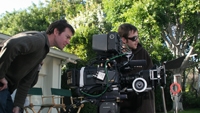Wasserman makes feature debut with Panasonic AJ-HPX3000

Los Angeles-based filmmaker Sam Wasserman chose Panasonic’s AJ-HPX3000 native 1080p one-piece P2 HD camcorder to shoot his first feature, “The Journal,” a semi-autobiographical short.
Director of photography Graham Futerfas shot the movie, which premiered at the BendFilm Festival in Bend, OR, and was screened at the Hollywood Film Festival last fall.
According to Futerfas, when Wasserman approached him about shooting the project, the filmmaker wanted to capture the look and feel of 35mm film, which was beyond his budget. The pair settled on the Panasonic HPX3000 largely due to its 10-bit AVC-Intra codec and full-raster 1920 x 1080 capture, he said.
“I’d been extremely concerned about an ‘HD look’ prior to shooting, but the HPX3000 impressed me with its clarity of image and filmic rendition of colors, even in the raw footage,” Wasserman said.
The movie was shot in February 2008 in Venice, CA at three locations — a 20ft by 20ft therapist’s office, a home and a cemetery. The project consisted almost entirely of daytime scenes, both interior and exterior.
The production’s equipment package included a five-ton grip and lighting package, generator, HMIs, Fisher 11 dolly, a 3ft camera slider, a Steadicam and 18ft jib/crane.
The camera package included a Canon 21x7.5 Cine Style zoom lens and Canon 11x4.7 ENG lens for Steadicam, wide-angle and lightweight needs. Additionally, a Panasonic BT-LH1700W 17in HD monitor was used on location and a BT-LH900A 8.4in HD monitor was onboard the camera. A Leader 5750 waveform/vectorscope, Tiffen SoftFX 1 filter and Pola and ND filters rounded out the package.
The professional video industry's #1 source for news, trends and product and tech information. Sign up below.
The camera was loaded with 32GB P2 cards, which were swapped as frequently as possible, Futerfas said. The project’s media manager continually imported and transferred material to a MacBook Pro throughout the day. To do the transfer, the manager used a Duel-Systems adapter for the MacBook Pro and drag-and-dropped the “Contents” and “LastClip.txt” from each P2 card onto two separate 1GB hard drives for backup. Final Cut Pro Log and Transfer functions were used to make ProRes HQ files.
The ProRes HQ files were edited in Final Cut Pro. When finished, they were output to D5 HD via HD-SDI card, color-corrected on a daVinci 2K in HD and mastered to another D5 HD deck, with sound then laid back.
For more information, visit www.panasonic.com/broadcast.
